Robotics team FireWires advances to world championships. Now it has to raise money to go.
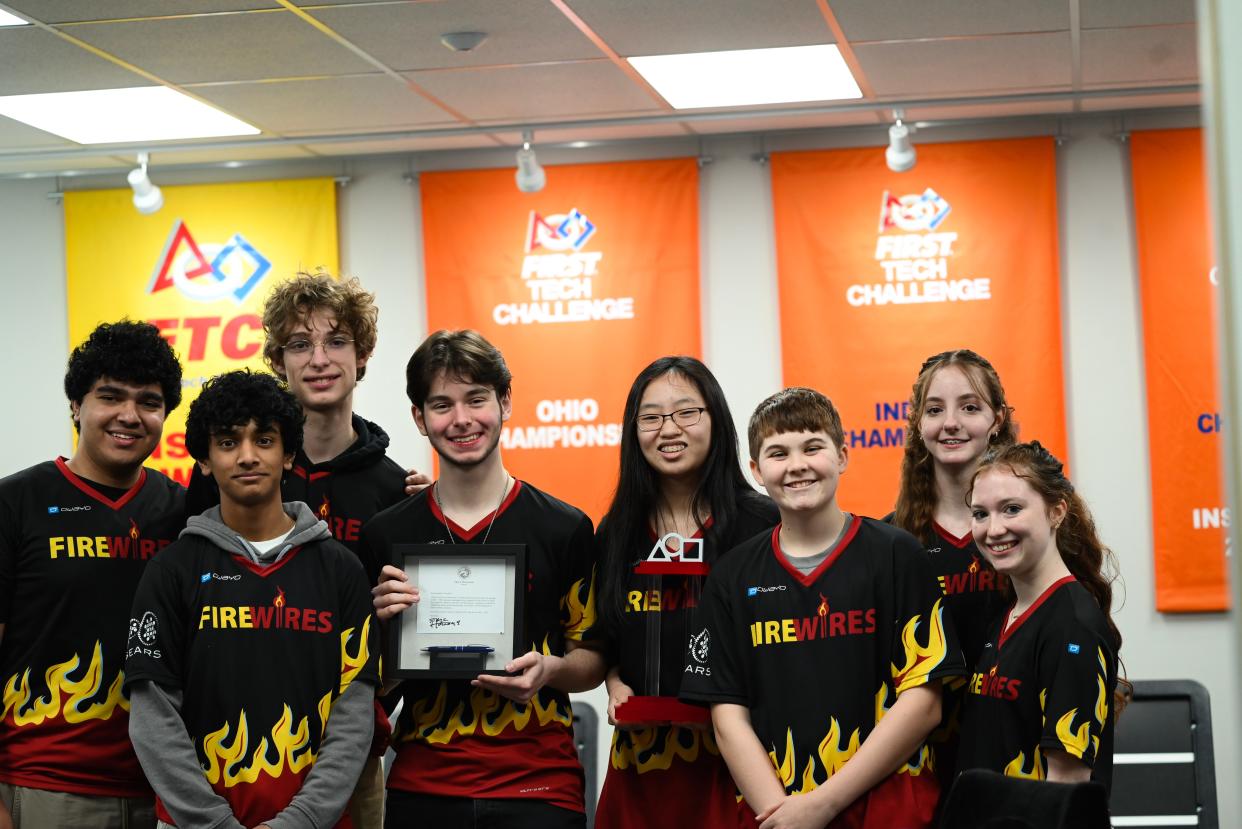
OSCEOLA — Ambition runs deep for the eight high school students who make up the robotics team FireWires.
Most recently, they earned an invitation to the FIRST World Championship in Houston, Texas, with only one obstacle standing in their way: funding.
The FireWires take their name from the failed high-speed data transfer unit that USB beat out. Although the FireWire device didn't stick, the resiliency of the team, embodying the name and design, did. They qualified for FIRST World after winning the Indiana State Championship on March 9, but soon asked: How would they raise the money to get there?
The next day, they started fundraising.
FireWires' head mentor, Rich Lester, called the budget “scary,” as he detailed the amount they’d have to raise to make it to Houston on April 17. He said it’ll cost $26,000 to go. Registration for FIRST World, $2,500, has been paid, but greater expenses loom, including $13,800 for hotel rooms for eight students, three coaches and three mentors and $3,000 for flights.
Their funding primarily comes from donations and fundraising. Everything they have, including TV monitors, drywall and paint at their GEARS practice space, has been donated.
Overcoming adversity
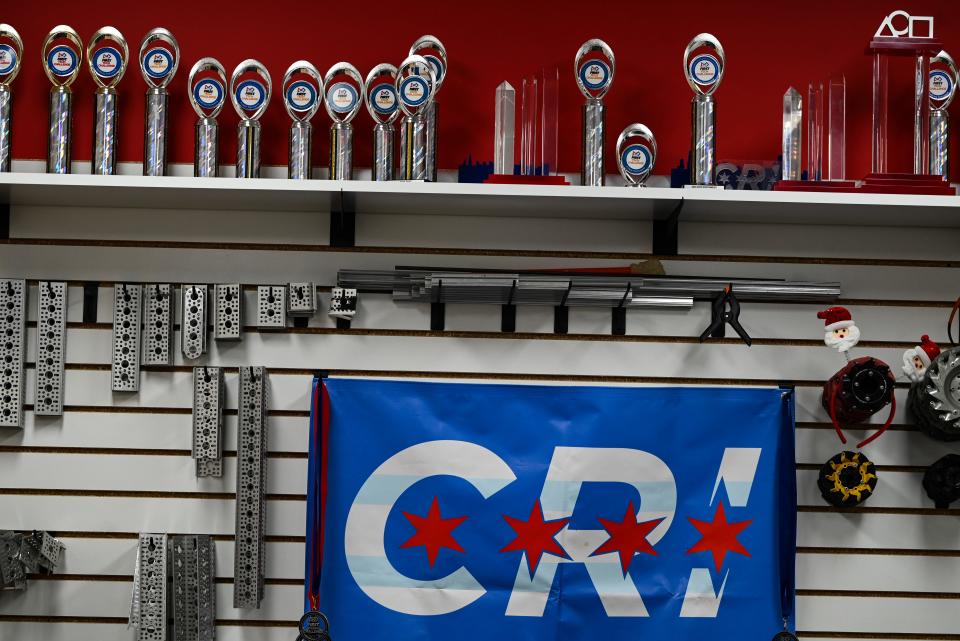
This season is the FireWires' first invitation to the world competition, and they're pretty confident going in.
“Indiana has never brought back gold from Worlds," 16-year-old Nate Baker said. "A lot of teams, when they go to Worlds, they say, ‘We’re gonna have a great time.'"
But, Nate said, FireWires' goal is different.
"We are going to have a good time,” he admitted, “but the way we have a good time is by winning.”
FireWires' team members pooled their skills to design, build and code their robot to perform a series of tasks. The robot's intake system uses surgical tubing and a silicon counter-roller to pick up hexagonal-shaped tiles — known as "pixels" — off the floor. The robot then drives to a board where it pivots the pieces to the robot's arm and places the tiles in a specific order to score.
“Each of them brings their own talents to the team," team mom Saira Rahman told The Tribune. "They’re at a point where they work so well together that they know exactly what they need to do. It’s becoming a well-oiled machine."
When the team won state, it was the eighth best in the world, but as more competitions play out, its ranking will change. On Sunday, March 17, the FireWires dropped to 11th place. Lester anticipates them to drop a few more spots before FIRST World as more teams qualify. To them, it’s still an incredible accomplishment.
“Even if we’re not the best team at the competition, we still have a solid shot at winning our division,” Nate said.
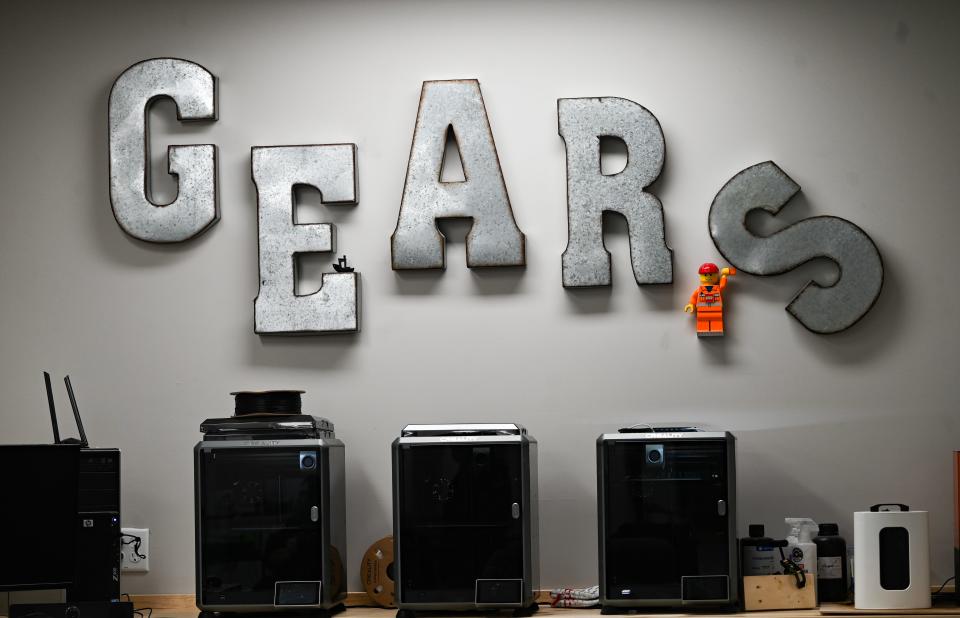
Their current bravado comes from a healthy dose of humility earned in past seasons.
“Last season, we didn’t do great,” Penn High School junior Raafe Rahman, 17, said, saying their worst competition was the Maryland Tech Invitational.
“We were really trying to be good that year,” St. Joseph High School's Zachary Thain, 16, added, saying their inconsistencies got the better of them.
Raafe admitted to having a lot of reliability issues, which he described as not having a seamless transition between the programming and hardware. Last year, the team allotted a week and half to programming prior to their first competition, causing them to always play catch up when it came to reliability. “That royally screwed us over,” Raafe said. “We didn’t have a great programming set up, and it repeated itself throughout the season.”
To him, the experience was “demoralizing,” but he said it helped them grow a lot.
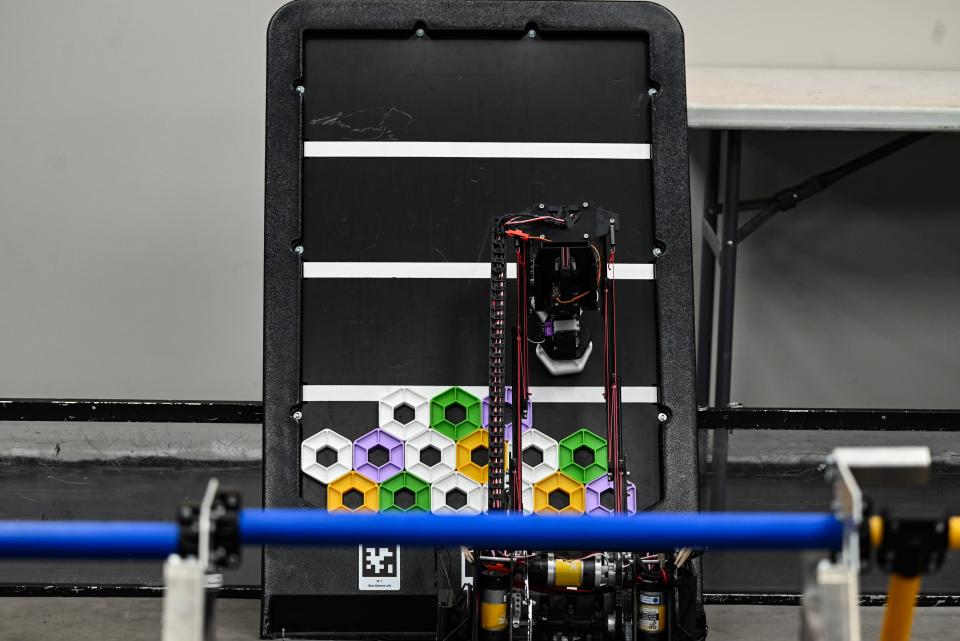
Zach, grateful for the opportunity to grow, said this year, the team put twice as much time into their efforts.
“We realized unreliability is not going to cut it," Zach said, "This year, we put an emphasis on trying to make our robot reliable.” He credited the stress of last year for his determination now. “When your robot isn’t doing the same thing every time, it’s hard to practice and get good,” he said.
Lucy Noie, 17, added that they put an emphasis on baby steps this year. “Don’t fly too close to the sun,” she cautioned.
“It’s disappointing to put in the hard work and have it not pay off,” Raafe said, but now they know what that feels like. "At the end of the day, it helps us prepare for the future,” he said.
Writing House Bill 1382
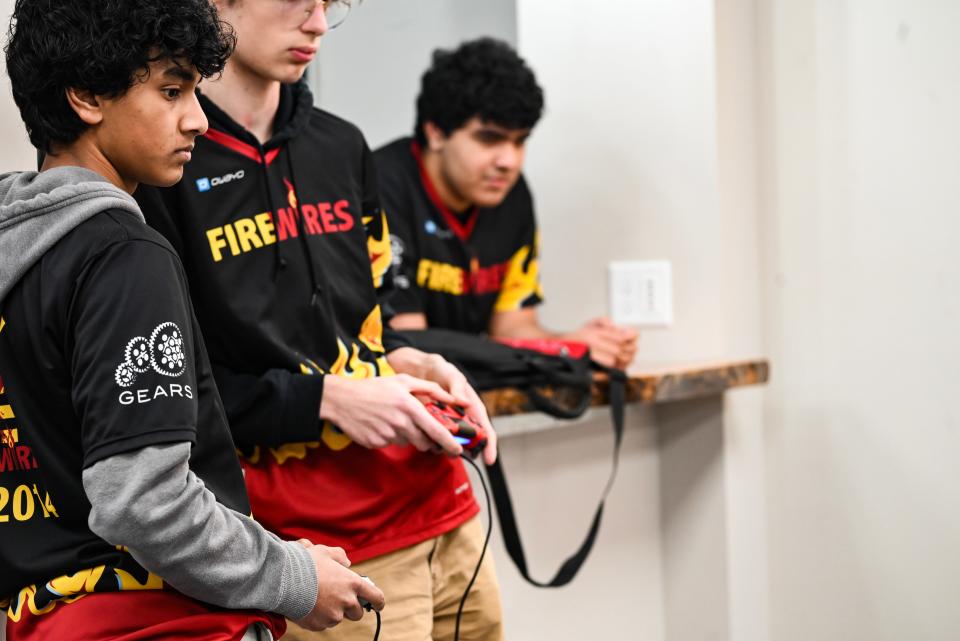
But funding has also been one of the many hurdles the team has faced for years. In fact, FireWires enlisted the help of state lawmakers to get more funding for robotics programs in Indiana.
Lucy, FireWires' programmer, recalled visiting the Indiana statehouse as a freshman in spring of 2022 to advocate for what's now House Bill 1382. She remembered Gov. Eric Holcomb shaking her hand. The team proposed the bill to State Rep. Chuck Goodrich (IN-29), the president of Gaylor Electric Inc., who, according to Lucy, said, “I like your idea. I’ll write the bill for you."
During that summer, the team met with Goodrich “to talk about the more nitty-gritty of the bill,” she recalled, such as funding for Indiana schools’ robotics programs and coach stipends. “With all of the STEM jobs popping up, people need to go into those jobs that have a lot of demand right now," she told The Tribune, where her father, Tom Noie, is a sports columnist.
Now a junior at Penn High School, Lucy said she returned to the statehouse last year to continue advocacy for the bill and testified in front of a committee. She called the experience “mentally frightening,” saying she didn’t prepare to speak to as large of a committee as she did.
Nate also spoke in front of a committee last year and shared his experience.
Their efforts paid off.
House Bill 1382 passed the General Assembly on April 24, 2023, in a near-unanimous vote. On May 4, 2023, Holcomb signed the bill, and it went into effect for the 2023-24 season.
Schools apply for the Indiana Department of Education's K-12 Robotics Competition Grant to receive money to cover mentor stipends, kits and supplies, event registrations, and transportation and travel.
As originally written, public, charter and state-accredited nonpublic schools qualify to apply for the grants. The guidelines are based on the team's level of programming, level of competition and number of participants.
The FIRST Indiana Robotics Maximum Award per team at a high school level is $10,000 for their initial season and $6,000 for each subsequent season. The grant also requires applicants to "provide evidence of local in-kind or cash contribution from other private or local funds in an amount equal to at least 25% of the amount of the awarded grant."
The Tribune previously reported that HB 1382 would provide $4 million in funding to robotics teams across Indiana, benefiting programs such as FIRST (which means For Inspiration and Recognition of Science and Technology) Lego League (FLL), FIRST Technology Challenge (FTC) and FIRST Robotics Competition (FRC). However, it only applies to school-based teams: eligible schools include public, charter and state-accredited nonpublic schools. Eligible teams must be enrolled through an eligible school.
The FireWires, a community team through GEARS, with participants from several local eligible high schools, doesn't qualify. "While they are enrolled into an eligible school, the team is not part of an eligible school because our program itself is not a school," Lester said. "We self-fund our program through our own organization, so we don't qualify as a school."
Even as the FireWires helped plan the bill with Goodrich, they knew it wouldn't benefit them. The plan was to start small, not asking for too much, in an effort to help some teams now and make amendments that would help them in the future.
“The goal of this is to make it an equal playing field,” Nate said, “to make sure everyone has the same opportunities that we do.”
And now, as a result of this year's General Assembly session, they will have the same opportunities as school-based robotics teams beginning with the 2024-25 school year: A few days after FireWires' win at the state competition, Holcomb signed the unanimously-passed House Bill 1233 on March 11.
The bill amended the definition of "eligible school" to include a nonpublic school accredited by a national or regional accreditation agency that is recognized by the state board and "eligible team" to include a community-based robotics competition team.
The team's head mentor, Lester said that under the amended "eligible team" definition, FireWires should qualify for the grant next season, but it'll be up to the IDOE to award the grants.
HB 1233 will take effect July 1.
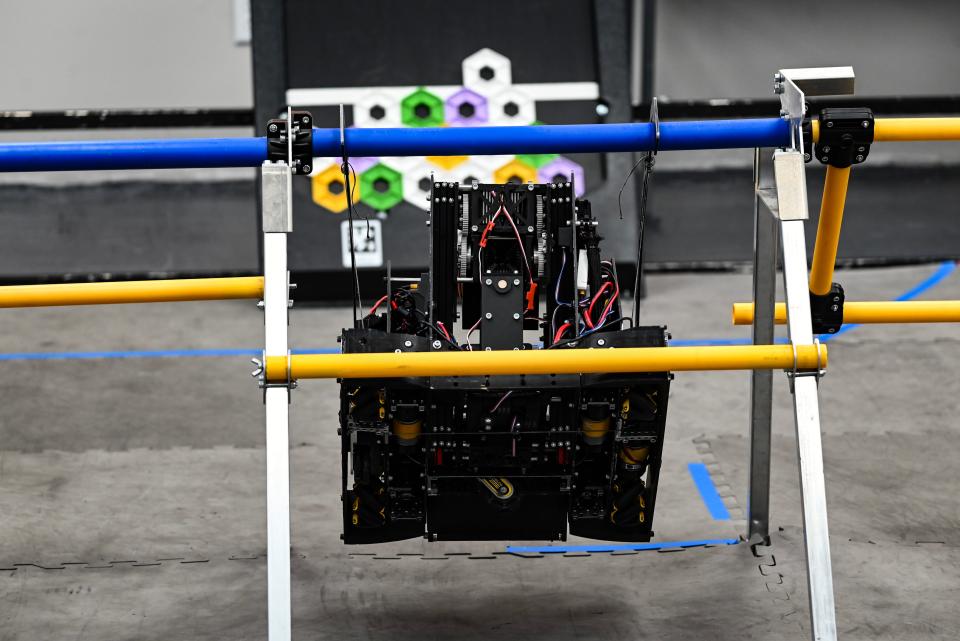
Preparing for the FIRST World Championship
The team continues to make adjustments to their robot between now and the competition. They put in an estimated 136 hours after school this season.
“They’re one of the top-ranked teams in the world right now," Lester said, "but they do want to change a couple of things.”
Although the team works together, they have their individual roles on the team.
Raafe aids the team with Computer-Aided Design by designing the robot prior to building it.
He looked at the CAD for their new intake system, which picks up the hexagonal pieces off the floor to be delivered to the board for points. The team had previous issues with their intake working at state competitions, so they’re working on modifications now.
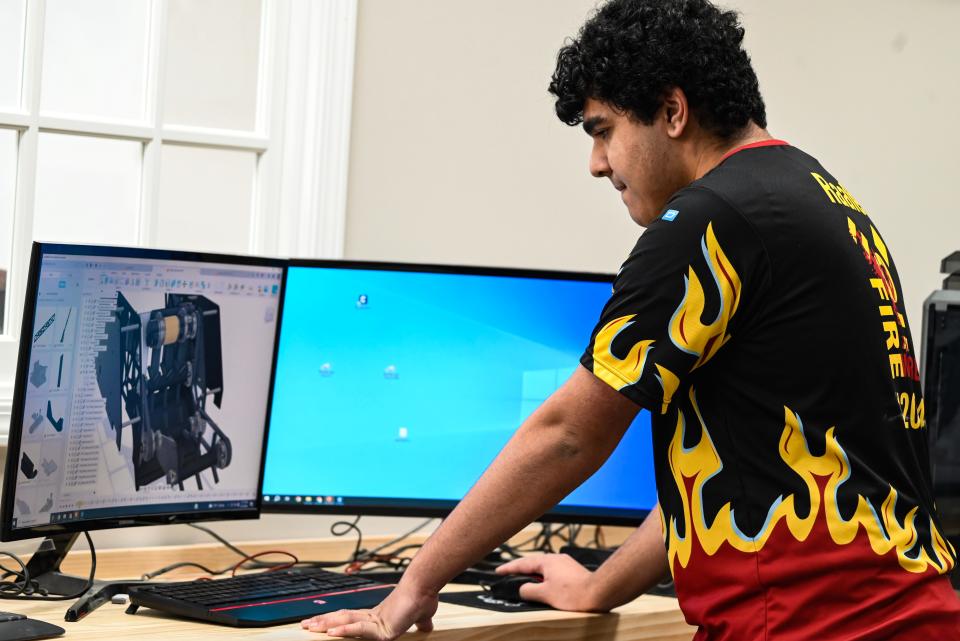
“I’ve been continuously learning new stuff every season,” Raafe said.
Raafe started his freshman year working with CAD. Now, as a junior, he said robotics has had an impact on his college trajectory. He’s always had an interest in engineering, but he wasn’t committed to it until he started robotics. At that moment, he realized, this is definitely what he wants to do, he said. He now hopes to get into a mechanical or aerospace engineering program at Purdue University or the University of Michigan.
“We’re overall happy with it,” Lester said of their robot's current status. It excels in the major ways to score points: placing hexagonal-shaped pixels on a board, raising their robot off the ground during endgame and launching a paper drone to land within a specific margin on the floor.
Zach has been the main mind behind the drone launch.
In his second year, Zach decided he wanted to design and build. “It gave me free range to work on my own module.” This season, he worked on the drone launch, which, he said, had over 30 versions, the most renditions out of everything else on the robot.
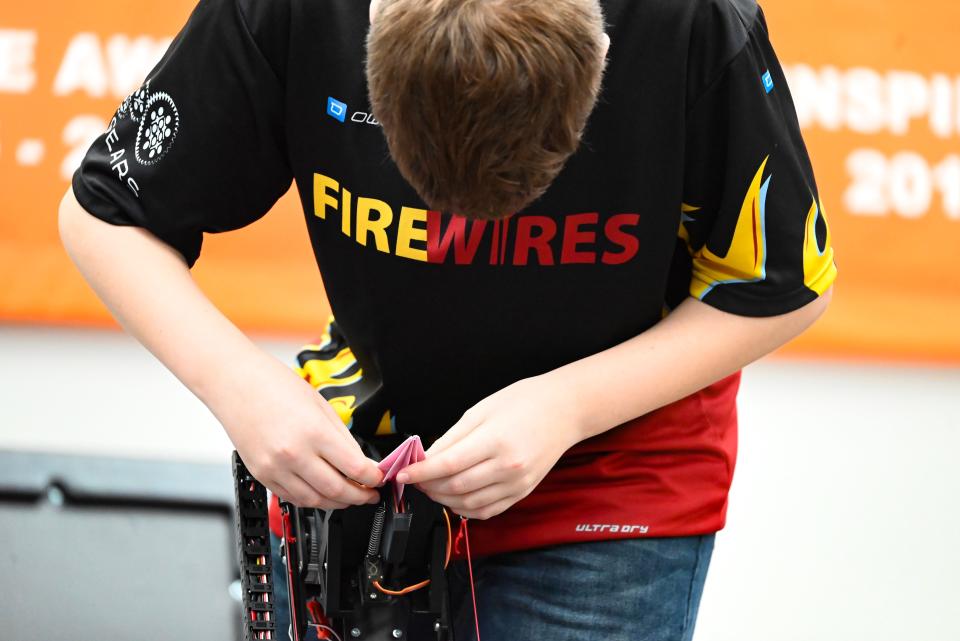
“It did really well at State,” Lester said. “The only time it missed was due to outside interference.”
“The plane has been very difficult to tune, but once you get it down, it starts to work well,” Zach said. “We’ve definitely failed quite a bit in our time, but it’s only made us stronger."
How to donate
View the link on GEARS' website to donate to FireWires’ trip to the FIRST World Championship: https://gears.org.in/.
Email Tribune staff writer Camille Sarabia at csarabia@gannett.com.
This article originally appeared on South Bend Tribune: FireWires face funding hurdle before chance to win Worlds next month

